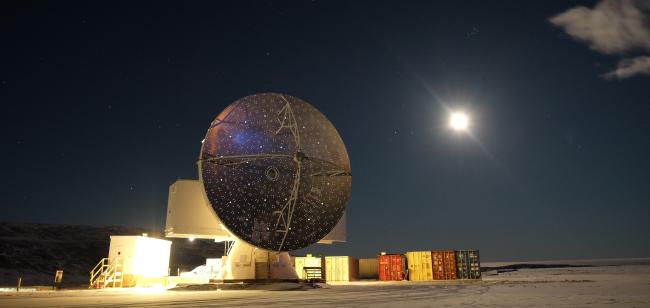About

The Greenland Telescope (GLT) is a 12-m diameter submm-wavelength
radio telescope located at the Pituffik Space Force Base in Greenland.
It offers the northernmost extended baseline for very-long-baseline
interferometry (VLBI), spanning about 9,000 km from the Atacama
Large Millimeter/submillimeter Array (ALMA) in Chile, and to the
Submillimeter Array (SMA) and the James Clerk Maxwell Telescope
(JCMT) in Hawaii.
The main scientific objective of the GLT project is to conduct VLBI
observations of supermassive black holes (SMBHs) in the nuclei of
galaxies at frequencies of 86, 230, and 345 GHz. These observations
aim to achieve a high angular resolution of tens of microarcseconds
as part of the Event Horizon Telescope (EHT). By imaging the shadows
of SMBHs, which are estimated to be five times larger than their
event horizons[1,2], the GLT project seeks to directly measure the
mass and spin of SMBHs, providing the first evidence of their
existence. The initial target for these observations is the SMBH
in M87, situated at a distance of 16 Mpc. In addition to the EHT,
the GLT also participates in observing campaigns with the Global
Millimeter VLBI Array to study active galactic nuclei sources and
gain insights into accretion disks and jet physics[3]. In future,
the GLT will observe at higher frequencies (e.g., 690 GHz), as part
of the Next Generation EHT (ngEHT), after it is moved to the Summit
station site (see below).
The GLT project is a collaboration between the Smithsonian Astrophysical
Observatory (SAO) and the Academia Sinica Institute for Astronomy
and Astrophysics (ASIAA). Initially, the GLT antenna was the ALMA
North America prototype antenna located near Socorro, New Mexico[5].
In 2011, the antenna was awarded to the SAO and ASIAA/SAO team for
relocation to Greenland by the National Science Foundation and
Associated Universities, Inc. (AUI)/NRAO.
ASIAA has led the GLT project, securing most of the budget for the
antenna refurbishment and successfully deploying it in Thule. Between
2012 and 2016, ASIAA and the SAO team worked rapidly to refurbish
the antenna, incorporating new components to meet the extreme Arctic
operating conditions. These components included parts of the backup
structure, carbon-fiber quadruped legs, a sub-reflector and its
hexapod controller, a servo system with motors and gearboxes, an
antenna control unit, and a set of elevation bearings[6].
Currently, the GLT is equipped with three VLBI receivers operating
in the 84–96, 213–243, and 271–377 GHz bands[7]. All receivers and
backend systems have been tested and meet their performance
specifications. The GLT benefits from built-in calibration and
diagnostic systems in all its instrumentation[8], facilitating the
testing and observation process. The telescope's operations began
with single-dish testing activities in December 2017, followed by
various observations, including the Moon in continuum mode at 86
and 230 GHz, spectral line observations of the CO J = 2–1 line from
Orion BN/KL, and the successful acquisition of VLBI fringes in
January 2018. In April 2018, the GLT conducted successful EHT
observations[9].
The future plan for the GLT is to relocate the antenna to a site
near the Summit station in Greenland, situated at an altitude of
3,100 m above sea level. This move aims to take advantage of lower
and more stable atmospheric opacity, providing excellent transparency
at frequencies higher than 345 GHz[10]. However, this plan is still in
its preliminary stage and will require significant infrastructure
development near the Summit station, as well as additional funding
support over the course of three years.
References:
[1] Doeleman, S. S. Nat. Astron. 1, 646 (2017).
[2] Psaltis, D. & Özel, F. Phys. Today 71, 70–71 (April 2018).
[3] Inoue, M. et al. Radio Sci. 49, 564–571 (2014).
[4] Hirashita, H. et al. Publ. Astron. Soc. Japan 68, 1 (2016).
[5] Mangum, J. G. et al. Publ. Astron. Soc. Pac. 118, 1257–1301 (2006).
[6] Raffin, P. et al. Proc. SPIE 9906, 99060U (2016).
[8] Chen, M.-T. et al. Proc. SPIE 10700, 107000H (2018).
[8] Kubo, D. et al. Proc. SPIE 10708, 1070816 (2018).
[9] Matsushita, S. et al. Proc. SPIE 10700, 1070029 (2018).
[10] Matsushita, S. et al. Publ. Astron. Soc. Pac. 129, 025001 (2016).